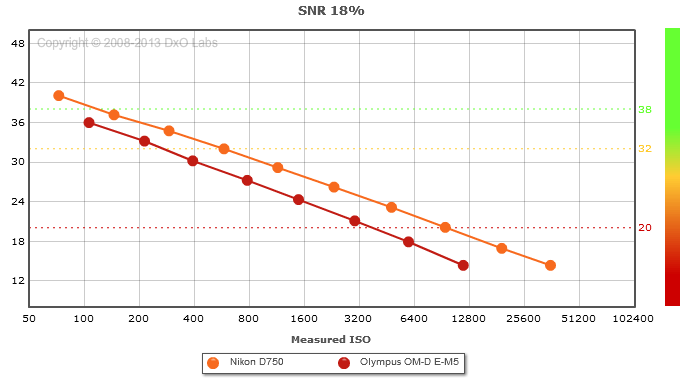Universal Creations schreef op woensdag 13 mei 2015 @ 10:11:
[...]
Dat was nu niet het punt. Het ging om mijn opmerking over ruis bij de laagste iso-waarde. Het komt er voor mij op neer, dat je met mft niet de keuze hebt om geen ruis te hebben in je foto's. Iets wat met fullframe wel mogelijk is. Ik snap dan ook totaal niet waarom m4/3 gaan lagere base-iso hebben dan iso200.
Het hangt er maar net van af hoe je ISO meet. Qua belichting geeft ISO200 op m4/3 je gewoon wat je zou verwachten, maar met meer ruimte in de highlights (minder clipping) waardoor het in die zin een hogere ISO heeft.
Bij DxOMark zie je dit enigszins terug, daar meten ze de SNR18% a.d.h.v. de 'measured ISO' en niet de 'manufacturer ISO'. En dan gaat de e-m5 plots wel tot ISO100:

Dan zie je dat ISO200 op de E-M5 (measured ISO = 100) één dB minder signaal heeft dan ISO200 op de D750 (measured ISO = 150).
Deze uitleg vond ik zelf wel verhelderend wat dat betreft:
I think you have a misunderstanding of what the sensor ISO means. There are two fundamentally different ways of defining ISO.
1) The industry-standard definition of sensor ISO is based on the amount of light it takes to saturate the sensor (produce a value equal to pure white). That's important to know, because any exposures greater than that just get clipped. It can produce counterintuitive values. If you double the efficiency with which the sensor captures photons and converts them to photoelectrons, leaving all its other characteristics unchanged, then it only takes half as much light to saturate the sensor and you've doubled the ISO. That make sense.
But… Suppose you make a sensor that just has larger pixels or deeper wells, so that it can hold more photoelectrons. Not changing anything else about it, just giving it a longer dynamic range. What happens then? Well, it takes more light to saturate the sensor. Which means its sensor ISO **DROPS**! But it still has the same sensitivity to light at any given level. WTF?
As I said, counterintuitive.
This is one reason why many large format digital backs, with their huge pixels and huge dynamic range (which means a huge exposure range) come in with such low ISO values. Their pixels aren't insensitive, but they are designed to be huge light buckets, so it takes a lot of light to fill them.
2) The industry-standard definition for camera ISO, and the one that makes the most intuitive sense to photographers, is based on evaluating real photographs to determine which exposure produces the best looking results. It doesn't directly connect to what exposure saturates the sensor. That is just one factor. For example, less exposure (higher ISO) leaves you with more highlight headroom before you start getting clipping, but the picture will look noisier. Conversely, more exposure (lower ISO) produces a cleaner photograph but your highlights will block up sooner.
One result is that you can get different camera makers deciding on different camera ISOs for the very same sensor, depending on what they think is the optimum balance for image quality. But almost always, they will choose a camera ISO that is somewhat less than the sensor ISO (unless it's a VERY long-dynamic-range sensor) because blown-out highlights are unpopular.
Another consequence is that the camera ISO can change with the camera design, even with the same sensor. The noise in the picture isn't just the result of the sensor characteristics, it's the result of the entire electronic chain, the amplifiers and all the rest. Different electronics designs will produce different amounts of picture noise for the same exposure with the same sensor. That affects the balance between what are acceptable levels of noise and an acceptable range of highlight detail. Lower noise means you can increase the camera ISO and still get good image quality. But the sensor ISO hasn't changed!
That's why DxOMark gives you a plot of camera ISO vs. sensor ISO. It doesn't reveal that a camera manufacturer is “fudging” or “lying.” It tells you how the two different kinds of ISO, which are legitimately determined in very different ways, compare.
That's all. It's not an exposé. It's just technical information. So far as real photography practices go, that particular plot isn't important.
(zie daarvoor
deze blogpost)
Maar misschien dat iemand hier (mrc4nl? UC?) daar meer over weet. Ik wilde alleen ooit weten of de ISO-low stand nuttig was of niet

Verder interesseert het me bijzonder weinig.
Daarnaast is er nog een andere vraag: waarom besteden sensor-fabrikanten zo weinig (eigenlijk helemaal geen) aandacht aan lagere ISO's? Iedereen loopt maar met ND-filters en pola's rond om maar wat bokeh te kunnen krijgen

Geef mij die ISO 25 maar terug die men vroeger met film wel had. Of nog beter: geef me ook maar ISO 12. Dan kan de ND8-filter de prullenbak in.
Olympus heeft een tijd terug wel aangegeven dat ze ook graag lagere ISOs mogelijk willen maken, maar in hoeverre ze dat gaan verwezenlijken is nog maar de vraag. Dan zouden ze eerst weer hun eigen sensors moeten gaan gebruiken lijkt mij. Volgend jaar komen ze schijnbaar met een nieuwe 'revolutionaire' sensor, maar ik heb nog niks gehoord over ISO-bereik van die sensor.
[
Voor 3% gewijzigd door
link0007 op 13-05-2015 11:36
]
:strip_icc():strip_exif()/u/373647/b1aa8209a437bf987cf066823c044f0a.jpeg?f=community)
:strip_icc():strip_exif()/u/6995/crop5778dcb1264b5_cropped.jpeg?f=community)
:strip_exif()/u/185685/walking_boxes_s.gif?f=community)
:strip_exif()/u/227266/Mantis0509_01-1_klein.gif?f=community)
/u/380617/crop5ea17f1cefb4c_cropped.png?f=community)
/u/18893/chrome_logo.png?f=community)
:strip_icc():strip_exif()/u/1981/Image00001.jpg?f=community)
:strip_icc():strip_exif()/u/162143/crop5b6d888e9cc79_cropped.jpeg?f=community)
:strip_icc():strip_exif()/u/47056/qasreshirin_mementomori11.jpg?f=community)


:strip_icc():strip_exif()/u/59664/crop63e2bd9de7d58_cropped.jpg?f=community)


/u/256438/crop5dbb270939de4.png?f=community)

:strip_icc():strip_exif()/u/39518/F2_Perk_Slayer.jpg?f=community)
:strip_exif()/u/82348/wscdude.gif?f=community)
:strip_icc():strip_exif()/u/18471/crop5c235b55e7866_cropped.jpeg?f=community)

:strip_icc():strip_exif()/u/496922/Balance%252060x60.jpg?f=community)
:strip_icc():strip_exif()/u/264672/trap60x60.jpg?f=community)












:strip_icc():strip_exif()/u/345457/1475785_572447966162984_524333390_n.jpg?f=community)